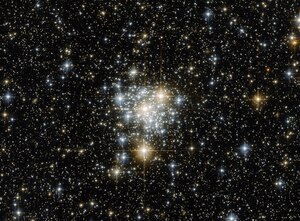NGC 299
(c) ESA/Hubble, CC BY 4.0 | |
| Aufnahme des offenen Sternhaufens NGC 299 mithilfe des Hubble-Weltraumteleskops | |
| AladinLite | |
| Sternbild | Tukan |
| Position Äquinoktium: J2000.0 | |
|---|---|
| Rektaszension | 00h 53m 24,0s [1] |
| Deklination | −72° 11′ 50″ [1] |
| Erscheinungsbild | |
| Helligkeit (visuell) | 11,73 mag [2] |
| Helligkeit (B-Band) | 12,05 mag [2] |
| Winkelausdehnung | 0,7' [3] |
| Rötung (Farbexzess E(B-V)) | 0,037 [1] |
| Physikalische Daten | |
| Zugehörigkeit | Kleine Magellansche Wolke [3] |
| Geschichte | |
| Entdeckt von | John Herschel |
| Entdeckungszeit | 12. August 1834 |
| Katalogbezeichnungen | |
| NGC 299 • ESO 51-SC5 • GC 168 • h 2360 • Kron 32 • Lindsay 49 | |
NGC 299 ist ein offener Sternhaufen im Sternbild Tukan in der Kleinen Magellansche Wolke und ist etwas weniger als 200.000 Lichtjahre von der Sonne entfernt.
NGC 299 wurde am 12. August 1834 von dem britischen Astronomen John Frederick William Herschel entdeckt.[4]
Weblinks
- The Toucan and the cluster (engl.)
- astronews.com: Bild des Tages 18. Oktober 2016
Einzelnachweise
Auf dieser Seite verwendete Medien
(c) ESA/Hubble, CC BY 4.0
The Toucan and the cluster
It may be famous for hosting spectacular sights such as the Tucana Dwarf Galaxy and 47 Tucanae (heic1510), the second brightest globular cluster in the night sky, but the southern constellation of Tucana (The Toucan) also possesses a variety of unsung cosmic beauties.
One such beauty is NGC 299, an open star cluster located within the Small Magellanic Cloud just under 200 000 light-years away. Open clusters such as this are collections of stars weakly bound by the shackles of gravity, all of which formed from the same massive molecular cloud of gas and dust. Because of this, all the stars have the same age and composition, but vary in their mass because they formed at different positions within the cloud.
This unique property not only ensures a spectacular sight when viewed through a sophisticated instrument attached to a telescope such as Hubble’s Advanced Camera for Surveys, but gives astronomers a cosmic laboratory in which to study the formation and evolution of stars — a process that is thought to depend strongly on a star’s mass.
Credit:
ESA/Hubble & NASA Coordinates
Position (RA): 0 53 24.35 Position (Dec): -72° 11' 49.67" Field of view: 2.04 x 1.51 arcminutes Orientation: North is 29.1° left of vertical
Colours & filters Band Wavelength Telescope Optical V 555 nm Hubble Space Telescope ACS Infrared I 814 nm Hubble Space Telescope ACS Optical V 555 nm Hubble Space Telescope ACS Infrared I 814 nm Hubble Space Telescope ACS.

